The Dell XPS 13 (9300) Review: Return of the King
by Brett Howse on July 16, 2020 10:00 AM ESTSystem Performance
When we reviewed the XPS 13 2-in-1 back in November, it was the first device we had tested which featured the new 10 nm Intel Ice Lake platform. At that time, Dell had also recently refreshed the XPS 13, but had outfitted it with the older 14 nm Comet Lake platform. For the all-new XPS 13, Dell has now brought parity to their lineup with Ice Lake here as well, with the improvements that platform brings, especially to the graphics side.
Dell offers three processor options. The least-expensive offering is the Core i3-1005G1, the mid-tier outfitted with the Core i5-1035G1, and the top-tier offering the Core i7-1065G7. Our review unit features the Core i7 model, as Dell wanted to put its best foot forward.
On the memory side, Dell’s spec sheet shows a 4 GB base, although thankfully that is nowhere to be found on their Dell.com site, at least for the USA. Thanks to the move to LPDDR4X with Ice Lake, Dell now offers up to 32 GB of memory on the XPS 13. Storage is all PCIe x4 NVMe, with 256 GB as the base, and a 2 TB maximum.
To see how the XPS 13 performs, we have run it through our newly updated laptop suite. Please not that if a graph does not contain a specific older device, that means that the test has not been run on it. Since the laptops are returned to the manufacturer after review, we cannot do any regression testing for the most part. If you’d like to compare the XPS 13 to any other laptop we have tested, please refer to our Online Bench.
PCMark
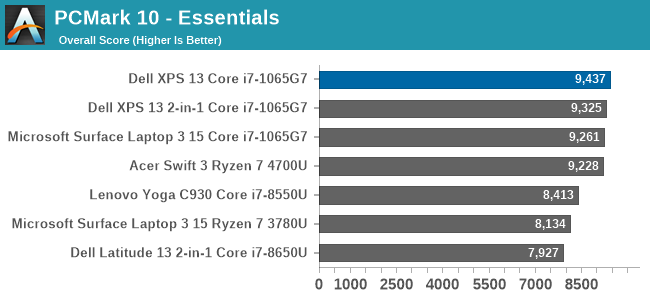
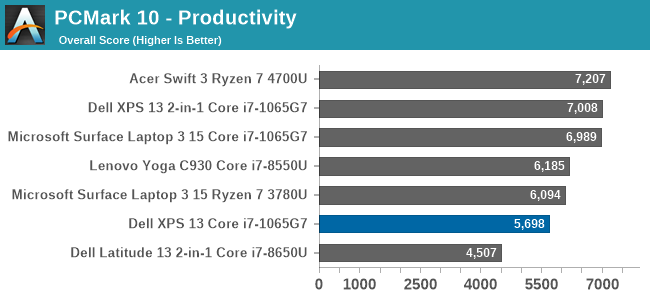
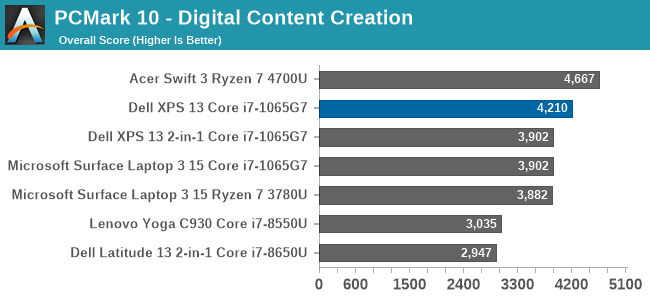
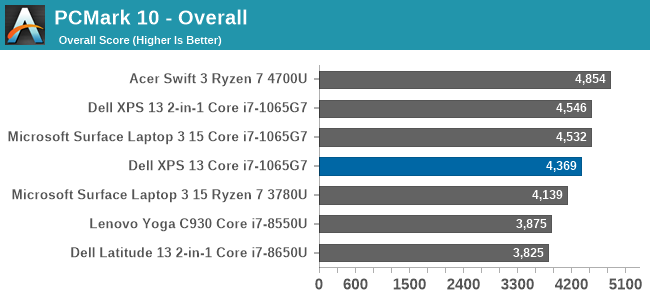
UL’s PCMark 10 is a whole-system benchmark, testing everything from CPU performance to app loading time. The Overall score consists of three categories, each featuring their own unique sub-tests. Overall the XPS 13 scored right in the same ballpark as other Ice Lake notebooks, although was slightly down in the Productivity tests, but slightly ahead in the other two.
Cinebench
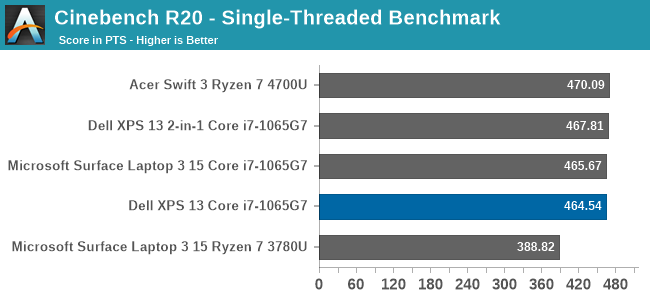
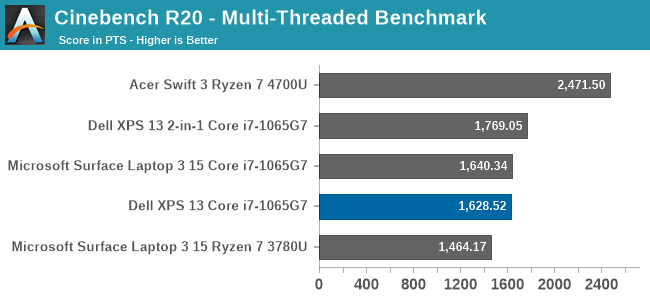
Cinebench, based on Maxon’s Cinema 4D rendering, allows tests of both single-threaded and multi-threaded runs, making it one of the more popular tests for overall computational performance. The XPS 13 does well compared to other Ice Lake equipped notebooks, although with AMD offering up to 8 cores in the same 15-Watt TDP, Intel falls behind in the multi-threaded run.
Handbrake
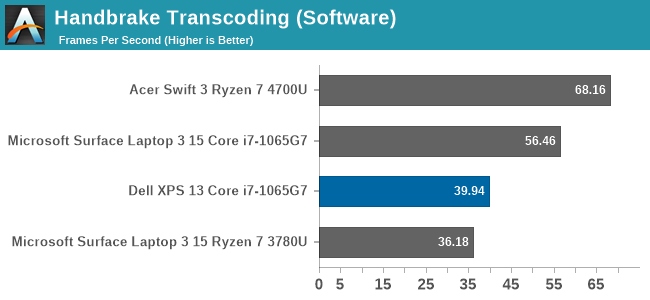
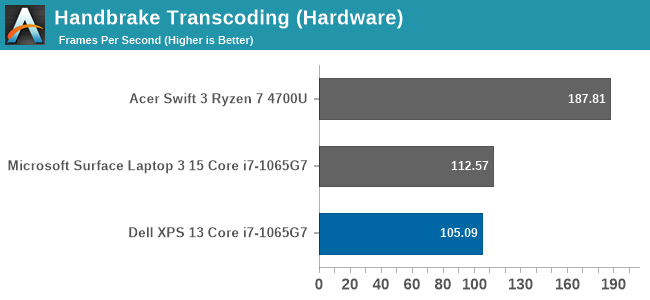
In our Handbrake encoding test, we transcode a 1080p movie to 720p using both software and hardware encoders. Software encoders utilize the CPU, and are generally the preferred method for optimal quality, whereas hardware encoders leverage the media blocks, which in this case is Intel’s QuickSync, for a much faster encode. As we will see more in the thermals section, Dell limits the XPS 13 to a 15-Watt TDP even in its maximum performance mode, where some other manufacturers will allow for higher than listed TDP, up to 20 Watts or so, and as such, the XPS 13 falls a bit behind other Ice Lake notebooks in this test which is TDP limited.
7-Zip


The popular file compression and decompression tool 7-Zip includes a built-in benchmark, and once again the XPS 13 slots right into where other Ice Lake notebooks fit.
Web Tests
Web performance is a function of not only the CPU performance, but also the browser’s scripting engine, and as such we have standardized on the Microsoft Edge browser. Microsoft has now transitioned their browser to the open-source Chromium project. Due to this, we have reset our web tests to use the new Chromium based Edge and taken the opportunity to decommission some of the older tests. We will now focus on Speedometer 2.0 and WebXPRT 3.
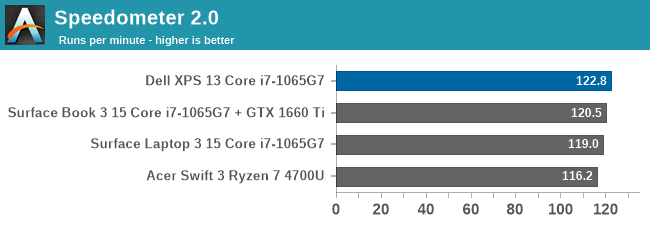
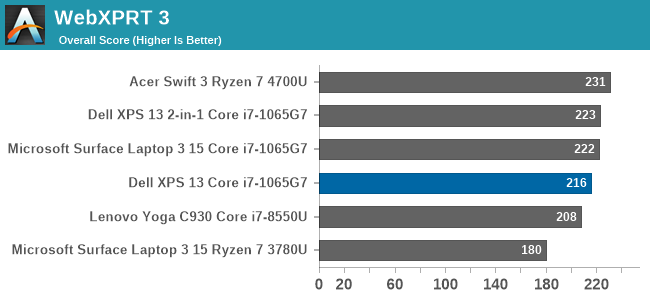
The XPS 13 again slots right in where you would expect for an i7-1065G7 based system.
Storage Performance
Dell offers from 256 GB to 2 TB of PCIe storage, and the review unit was outfitted with the Intel 600p 512 GB drive. We are transitioning to the PCMark 10 storage benchmark, which uses test traces of actual common workloads, such as booting Windows, and many of the Adobe applications, and as such should be a much better indicator of drive performance than just maximum transfer rates.
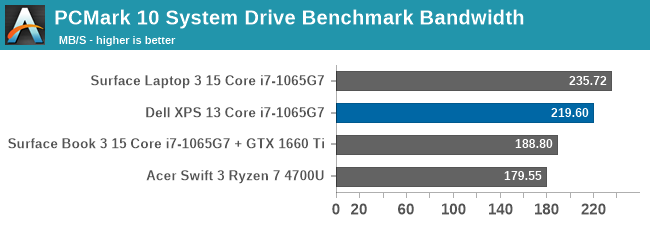
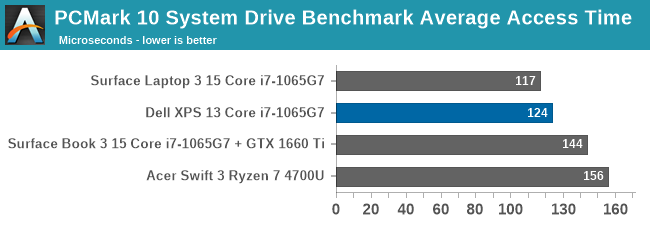

The Intel 600p performs quite well, with good access times and solid bandwidth. Surprisingly, it can’t quite match the excellent performance we saw from the SK Hynix 2230 form factor SSD in the Surface Laptop 3, but almost matches it.











224 Comments
View All Comments
serendip - Friday, July 17, 2020 - link
Surface models are the only mainstream computers to use a 3:2 ratio. I think 16:9 is only good for media consumption.cerfcanuck - Thursday, July 16, 2020 - link
Whenever I hear "soft-touch finish", I always wonder about long-term durability. In my experience (admittedly not with recent Dell products) such finishes have either scratched easily and/or turned "gummy" over time. Is this still a problem?willis936 - Thursday, July 16, 2020 - link
I have had an XPS 13 9343 for five years and the soft touch materials don’t feel aged. Five years isn’t very long term, but it’s a data point.I doubt these will go the way of the early 2000s mice that require a thorough hand wash after use.
Byte - Friday, July 17, 2020 - link
My lenovo Yoga 1 had softer touch. Its pretty thick. It did not get gummy but it is peeling off. Which is better than gummy I guess. About 8 years old.Retycint - Friday, July 17, 2020 - link
The soft touch did not age well for my XPS 15 9560. Gotten extremely sticky and started to peel off around 2 years in - this was of course not covered under warranty as it was considered "wear and tear".Context: I live in a tropical and humid country which probably accelerated the deterioration, so your experience may vary.
s.yu - Saturday, July 18, 2020 - link
My 2019 XPS 13 2N1 has this finish and leaves me wondering every time after I use the palm rest if I should wipe it with water, with alcohol, or just leave it. Good thing I often use it in tent mode(a must for stylus use) and use a BT keyboard, which sidesteps the whole issue.There is a tiny flaw on the finish though, it's a dent less than 1mm in diameter that looks like what's left of a burst bubble of a highly viscous fluid on a flat surface.
s.yu - Saturday, July 18, 2020 - link
Oh, FWIW I have a USB charger I bought about 6 years ago that claimed a "babyskin" finish, which feels similar to this "soft-touch" finish, I'm guessing some people really thought it's made of the skin of babies is why they dropped the name. It's often under somewhat high temperatures since it's a charging brick and it's softened with some wear at the corners, but it's only very slightly sticky.raystriker - Thursday, July 16, 2020 - link
Wonder if most of the premium ultrabooks will have an AMD offering by next year?eek2121 - Thursday, July 16, 2020 - link
Doubtful. Intel is very competitive in the mobile space and Tiger Lake is apparently dropping in September.Walkeer - Thursday, July 16, 2020 - link
what exactly do you mean by "very competitive in the mobile space"? more bugs? more power consumption? way less performance?